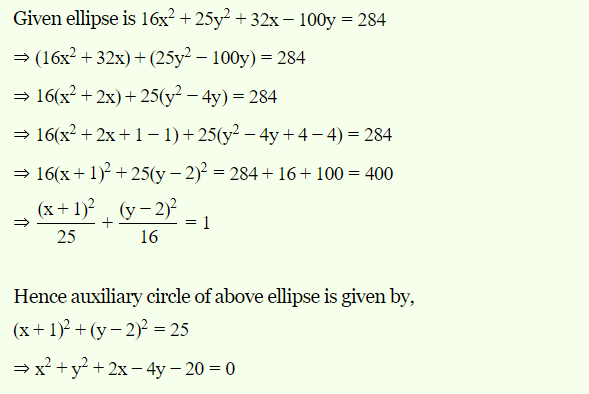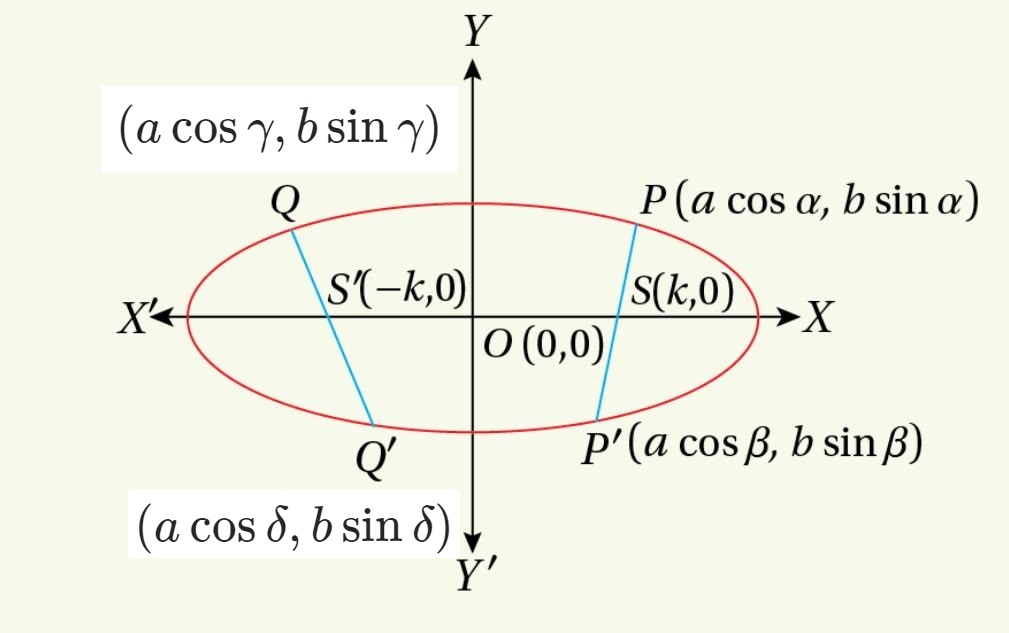In the previous article , we solved 7 solutions of Short Answer Type Questions (from 8-14) of Ellipse Chapter of S.N.Dey mathematics, Class 11. In this chapter, we will solve few more.

15. If ![]() be a variable parameter, show that the point
be a variable parameter, show that the point ![]() always lies on an ellipse.
always lies on an ellipse.
Solution.
![]()
From ![]() and
and ![]() we get,
we get,

Clearly, equation ![]() represents an ellipse. Hence, the point always lies on an ellipse.
represents an ellipse. Hence, the point always lies on an ellipse.
16. A point moves on a plane in such a manner that the sum of its distances from the points ![]() and
and ![]() is always constant and equal to
is always constant and equal to ![]() Show that the locus of the moving point is the ellipse
Show that the locus of the moving point is the ellipse ![]()
Solution.
Let the co-ordinates of the moving point be ![]() Also, let
Also, let ![]()

Hence, by ![]() we can conclude that the locus of moving point
we can conclude that the locus of moving point ![]() which represents an ellipse.
which represents an ellipse.
17. Find the locus of the point , the ratio of whose distances from the line ![]() and from the point
and from the point ![]() is
is ![]()
Solution.
Let the co-ordinates of the point ![]() be
be ![]()
The distance ![]() of P from the line
of P from the line ![]() is
is
![]()
Again, the distance ![]() of P from the point
of P from the point ![]() is
is
![]() .
.
By question,
![Rendered by QuickLaTeX.com \frac sd=2 \\ \text{or,}~~ s=2d \\ \text{or,}~~ s^2=4d^2 \\ \text{or,}~~ (h-8)^2=4[(h-2)^2+k^2] \\ \text{or,}~~ h^2-16h+64=4(h^2-4h+4+k^2) \\ \text{or,}~~ 64-16=4h^2-16h+4k^2+16h-h^2 \\ \text{or,}~~ 3h^2+4k^2=48.](https://examhoop.com/wp-content/ql-cache/quicklatex.com-019ee8c3f10da499d79c9f4a88f48fe1_l3.png)
Hence, the locus of the point is ![]()
18. The lengths of the major and minor axes of an ellipse are ![]() and
and ![]() and
and ![]() is the foot of the perpendicular drawn from a point
is the foot of the perpendicular drawn from a point ![]() of the ellipse on the major axis. Show that,
of the ellipse on the major axis. Show that, ![]() where
where ![]() and
and ![]() are the two vertices of the ellipse.
are the two vertices of the ellipse.
Solution.
The equation of the ellipse is ![]()
Let the co-ordinates of P be ![]()
The co-ordinates of the foot of the perpendicular drawn from ![]() on the major axis at
on the major axis at ![]()
![]()
![]() and
and ![]() are the vertices of the ellipse,
are the vertices of the ellipse,
![]() and
and ![]()
![]()
Since the point ![]() lies on the ellipse
lies on the ellipse ![]()

Hence, by ![]() and
and ![]() , we get
, we get
![]()
19. Show that for an ellipse the straight line joining the upper end of one latus rectum passes through the centre of the ellipse.
Solution.
Let the equation of the ellipse be ![]()
The co-ordinates of foci of the ellipse ![]() is
is ![]()
Now, the co-ordinates of the upper end of latus rectum passing through the focus ![]() is
is ![]()
Again, the co-ordinates of the lower end of latus rectum passing through the focus ![]() is
is ![]()
So, the mid-point of ![]() is
is ![]()
Hence, ![]() passes through the centre of the ellipse.
passes through the centre of the ellipse.
![]() Find the equation of the auxiliary circle of the ellipse
Find the equation of the auxiliary circle of the ellipse ![]()

21. If the eccentric angles of the two points on the ellipse ![]() are
are ![]() and
and ![]() then prove that the equation of the chord passing through these two points is
then prove that the equation of the chord passing through these two points is ![]()
Solution.
By question, let ![]() and
and ![]() be two points on the given ellipse
be two points on the given ellipse ![]()
Now, the equation of the chord ![]() of
of ![]() is
is

22. If the eccentric angles of the extremities of two chords which are passing through two points on major axis and the points are equidistant from centre of the ellipse, are ![]() respectively, then show that
respectively, then show that ![]()
Solution.

Let the equation of the ellipse be ![]()
Also, suppose that ![]() and
and ![]() are two chords of the ellipse whoch are equidistant from the centre of the ellipse. Consider that two chords intersect the major axis at
are two chords of the ellipse whoch are equidistant from the centre of the ellipse. Consider that two chords intersect the major axis at ![]() and
and ![]() respectively.
respectively.
Let the eccentric angles of the points ![]() be
be ![]() respectively.
respectively.
![]()
Now, the slope of ![]() the slope of
the slope of ![]()

Similarly, the slope of ![]() the slope of
the slope of ![]()
![Rendered by QuickLaTeX.com \text{or,}~~ \frac{0-b\sin\delta}{-k-a\cos\delta}=\frac{0-b\sin\gamma}{-k-a\cos\gamma} \\ \text{or,}~~ \frac{\sin\delta}{k+a\cos\delta}=\frac{\sin\gamma}{k+a\cos\gamma} \\ \text{or,}~~ k\sin\gamma+a\cos\delta\sin\gamma=k\sin\delta+a\cos\gamma\sin\delta \\ \text{or,}~~ a(\sin\gamma\cos\delta-\cos\gamma\sin\delta)=k(\sin\delta-\sin\gamma) \\ \text{or,}~~ a \sin(\gamma-\delta)=k(\sin\delta-\sin\gamma) \\ \text{or,}~~ \frac ka=\frac{\sin(\gamma-\delta)}{\sin\delta-\sin\gamma}=\frac{2\sin\left(\frac{\gamma-\delta}{2}\right)\cos\left(\frac{\gamma-\delta}{2}\right)}{-2\cos\left(\frac{\gamma+\delta}{2}\right)\sin\left(\frac{\gamma-\delta}{2}\right)} \\ \text{or,}~~ \frac ka=-\frac{\cos\left(\frac{\gamma-\delta}{2}\right)}{\cos\left(\frac{\gamma+\delta}{2}\right)} \\ \therefore ~\frac{k+a}{k-a}=\frac{\cos\left(\frac{\gamma+\delta}{2}\right)-\cos\left(\frac{\gamma-\delta}{2}\right)}{-\left[\cos\left(\frac{\gamma-\delta}{2}\right)+\cos\left(\frac{\gamma+\delta}{2}\right)\right]} \\ \text{or,}~~ \frac{k+a}{k-a}=\frac{-2\sin(\gamma/2)\sin(\delta/2)}{-2\cos(\gamma/2)\cos(\delta/2)}=\tan(\gamma/2)\tan(\delta/2)\rightarrow(2)](https://examhoop.com/wp-content/ql-cache/quicklatex.com-001ec63ba17e4adf42e2f6bed6c19d0f_l3.png)
Hence, from ![]() and
and ![]() we get,
we get,
![]()